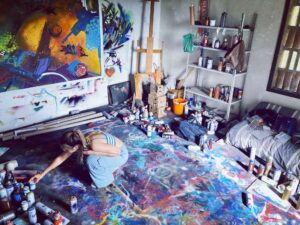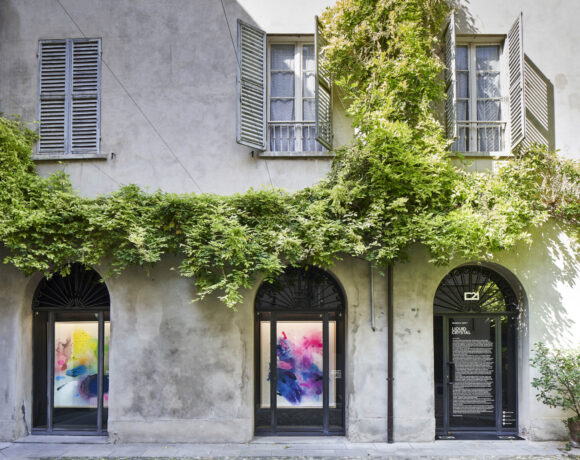I had the pleasure of meeting and interviewing Toxic, a New York graffiti artist, who amazed me with incredible stories that took me to the South Bronx ghetto of the 1980s, where he himself grew up. In my imagination, I find myself there, among the debris and rubble of the suburbs, walking down 149th Street and Third Avenue. There is Fashion Moda, the creative hangout of the new graffiti writers that was closed in 1993; it was the heart of hip-hop culture, where graffiti grew, those were the times of completely painted walls and trains. Graffiti is a youth social and cultural manifestation of mural painting that originated in the 1970s as part of the subculture present in New York’s ghettos – the latter known as hip-hop. However, the greatest expansion of graffiti occurred in the 1980s, more specifically in the South Bronx, thanks to the advent of spray painting. A revolution that saw for the first time the entry of black artists into a previously exclusively white art system. A change resulting from young people of different origins with a mocking and gentle air, the new kids of New York – as Francesca Alinovi used to define them. For the first time the street, and therefore life, officially entered the art system. An art that speaks, shouts, rebels. A public art, for everyone. Right here, at Fashion Moda, Toxic (one of the kids) presented his first exhibition. It was 1982, he was 17 years old and this was only the starting point of his journey. Born in 1965 in the South Bronx, his real name is Torrick Ablack. Toxic, like most of the kids from there, played basketball and skateboarded. In that 1982 he was bursting with creativity, but little did he know that he would change the conception of art and culture along with names like Keith Haring, Jean-Michel Basquiat, Andy Warhol, Madonna and the Rolling Stones.

Toxic, portrait. Ph. Giorgio Magini, courtesy the artist and ArtCan Gallery
Bianca Furbato: You started doing graffiti at the age of 13 with A-One and Kool Koor, with whom you joined Rammellzee’s Tag Master Killers crew, how did it all begin?
Toxic: I met A-One when I was 9 or 10 years old, we were neighbors and often skateboarded together. Through him, I became friends with Koor. We began doing graffiti in our neighborhood: South Bronx. During those years, I also started DJing and breakdancing, but graffiti was what I loved the most and what gaved me more satisfaction, I adored painting. A-One always pushed me a lot, and it was right through him that I met Rammellzee, who then introduced us to the Tag Master Killers crew.
Why were you given the nickname “Toxic Battery” during your childhood?
When we were kids, my friend Crave and I played basketball all the time. One day he told me: «Oh man, you play like you have toxic batteries», and I asked, «What does that even mean?». That day we played from the morning to the evening, so many hours that I became “Toxic Battery”, even though at the end of the day I was exhausted and had no more energy. That’s how my tag “Toxic” originated.

Toxic, 1990. Spray painting on metal panel. Courtesy the artist
Together with A-One, Koor, Rammellzee and his Gothic Futurism theory, you were in a war fighting against language and control. What was your goal?
When you live in New York, you realize the difference in growing up in the Bronx compared to Manhattan. It is not just about a social or economic level but also about language. In the Bronx we spoke a slang that people Downtown did not understand. In those years, as kids, we went to school to learn English. However, at that moment, you realize that English words are used to control you. The more intelligent you are and can use language to your advantage, the more you can achieve. Knowledge, along with language, can be wielded as weapons. Words are the bullets. This is where the futuristic attitude of destruction and annihilation towards a controlled language comes from. Rammellzee used armed letters and was the master of artistic gangsterism. Through our art, we wanted to create a new, liberated language.
The origin of Rammallzee’s artistic gangsterism can be found in medieval riddles. How is the Middle Ages related to your research?
At the time we were looking at medieval illuminated manuscripts, and Rammallzee used to study the original texts at the Bryant Park Library, at the intersection of 42nd Street and 5th Avenue. Of these we were interested in the capitals, letters disguised as pictures, somewhere between words and figures. Like the hidden letters of medieval codices, we wanted to hide and protect them. We wanted to equip them with weapons of our time: missiles. Thus, each of our graffiti was actually an armed letter, and each of us represented a letter: A-One the A, Koor B-One the B, I Toxic C-One the C. I then also represented the letters O, G and Q, which I had to defend. In doing so, we created our own alphabet through graffiti.
Defend against what?
From the control of language.

Rammellzee, EVOLUTION OF THE BOMBER’S LANCE, 1985. Courtesy the artist
You met Jean-Michel Basquiat in 1982, can you tell me about your first encounter? How old were you?
At the time I was 16 years old. On a Saturday night in 1982, encouraged by A-One, I went at The Roxie nightclub, on 18th Street in Downtown. During the night, I felt like taking a break from music, so I went outside in order to smoke. There was a guy next to me that I did not meet before, I passed him a few hits, and we started talking: «I’m Jean-Michel, I’m 21 years old» he says. Then we entered the club again and we started dancing, and we danced all night. At the end he stepped away for a moment, then came back and handed me a beer and said: «Look, this is my address, I’m having a party next week, come». The following week I was not sure if going or not, but then I ended up going. Arrived at the party I saw some limousines together with a lot of people. I went in, and there they all were, the great graffiti artists, my idols: Fab 5 Freddy, Futura, Dondi. I started to understand that Jean was an artist, and to grasp that graffiti was becoming more prominent, and recognized. From that night, a real friendship was born, it was right Jean-Michel who pushed me into the art world. «You have to paint canvases!» he used to tell me, and I used to reply: «I paint trains!», «But how do you eat with trains? You have to paint! Transfer what you do on trains onto canvas».
You were very close friends! Even Basquiat’s paintings reflect it: you are present in many of his artworks!
Of course, he was like a brother to me!
I listed to the single “Beat Bop”, produced by Jean-Michel in 1983 for Rammellzee and K Rob. Jean painted the cover of the original vinyl, making the single one of the most valuable rap records in the world.
Before producing “Beat Bop”, Jean was traveling in Los Angeles. At the time, Basquiat was dating Madonna, and she lived in his house in New York. One evening, with two friends of mine, we went to visit her and ended up doing a jam session: I on drums, Madonna on the keyboard, and my friend on the microphone. We then used Jean-Michel’s turntable and started recording. Later, Jean listened to the tape and decided he wanted to record “Beat Bop”. In those years we literally were in the middle of a creative hub!

Bianca Furbatto in Toxic’s studio, 2023.
What differences do you notice with today’s art world?
Today, the art world is much more individualistic and competitive. Back then we used to help each other out, there was a continuous exchange with other artists, which I do not see as much today. It is funny because with A-One, Rammellzee, Dondi, and Basquiat, we were all friends: «Oh man, I need to finish this thing, can you come and help?» «Sure!» «Hey man, I ran out of blue paint» «I’ve got it, come to pick it up!». Imagine, once Bruno Bischofberger, an important art dealer, wanted to buy a Basquiat piece. Jean-Michel told him: «I won’t sell you any painting unless you first buy a piece from Toxic». I was in the studio with Jean and Bruno but my work was still wet, I started using an hairdryer for the painting, I had windows wide open and fans trying to hurry the process. That is how it was: we were all like brothers, helping each other. Instead, the artists I know now do not have that spirit. Nowadays, the mentality is more like: «This collector is mine, this gallery is mine».

Toxic in his studio, 2023.
In 1984 you participated in the exhibition “Arte di Frontiera: New York Graffiti” in Bologna, conceived by Francesca Alinovi. You were 19 years old, what impact did this exhibition have on your career?
In the years before the exhibition, Francesca Alinovi used to come from Bologna to visit us, when we were still in the Bronx. Francesca was amazing, super cool, with this crazy hair! We were 18, she was about 35.
Why do you say she was super cool?
Because when she visited us she looked like one of us. She would hang out with us in the Bronx, smoking and drinking all together. Then, one night she told us: «I want to organize an exhibition in Bologna with you: young New Wave artists!». This exhibition introduced me, Keith Haring, Basquiat, Rammellzee and A-One to Europe and the institutional sphere of art. From the ghetto we had arrived in a museum. That exhibition changed my life and it is all thanks to Francesca.
In those years you graffiti artists used to exhibit all over Italy: Basquiat presented an exhibition in Modena in 1981, in 1984 “Arte di Frontiera” in Bologna was displayed, also Rammellzee in that period was working with the Fondazione Studio Carrieri Noesi, in Puglia. What correlation was there between the art of the New York ghetto and Italy?
At that time, Italy appreciated our art. There was a genuine interest in what we were doing. Prominent collectors, such as Moschino, used to hang out with us artists. Italy offered a different kind of appreciation, providing a fertile ground of high level.

Bianca Furbatto and Toxic in Toxic’s studio, 2023.
In the 1980s, you lived and were part of an artistic scene that is now studied in books. What is the revolution happening in art today, and where is it?
I am not very up to date with the contemporary scene, I have been out of the loop for the last ten years. Now I live here in my house in the country! In addition to the New York scene, however, I have also experienced the Paris scene, which is always very interesting. Today, however, I see that everything has moved to the internet and that marketing is starting to contaminate art.
Bianca Furbatto
Info:
Toxic

is a contemporary art magazine since 1980






NO COMMENT